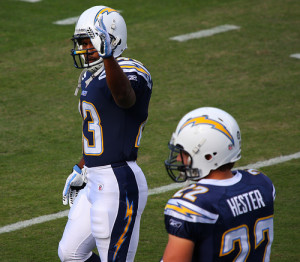
Although it’s hard to believe it’s been that long, Football’s Virtual Yellow 1st & Ten® line debuted on ESPN 17 years ago—a production enhancement that utterly changed the way fans watch football on television. Nowadays, the Virtual Yellow 1st & Ten® line is so much a part of the football experience that people sometimes expect to see it from the stands during live games.
On television, the Virtual Yellow 1st & Ten® line magically appears on the TV screen and displays down and distance, without interfering with the game. This gives viewers an easy way to identify where the first down marker was located on every play. Invented by Sportvision, a leader in sports broadcasting technology, the yellow line has been described as one of the most important sports broadcasting technology achievements to date. The virtual yellow line has become a staple of NFL and NCAA college football broadcasts.
What appears on TV screens today as if by magic, is a complex technology considered groundbreaking in 1998 when it was introduced. According to Bill Squadron, former CEO of Sportvision and now president of Bloomberg Sports, the idea for a virtual yellow line had been talked about since the late 1970s. “The reason why it had never been done was that no one had yet figured out how to insert, in live television, a virtual line that appeared to be under the players’ feet as if it were painted on the grass—and have that line stay in perspective as the action swirled around it and the cameras panned, tilted and zoomed,” he stated.
How Does It Work?
According to Shel Brannon of HowStuffWorks.com, painting the yellow line across the football field on your TV screen requires four SGI computers, one PC, and three special computers used in conjunction with the broadcast cameras and sensors that measure pan, tilt and zoom. Managing the process requires at least four technicians. Prior to the beginning of the game, the technicians create a digital 3-D model of the field on which the game will be played, complete with all of the yard lines. Every pixel on the television screen corresponds with an exact location on the field.
One of the challenges the technology addresses is compensating for the slight curve each football field has to help rainwater drain away. Another challenge is getting the colors right. The process uses what Sportvision CEO, Hank Adams, describes as a very sophisticated green-screen-like technology. “We’ve advanced the technology to have multi-color inclusion and exclusion zones. The green, of course, is not monochromatic—it’s brown, white, different shades of green. We pick out certain colors we know we’re going to see — the shade of pants and uniforms — then exclude those, so the line doesn’t interfere.” Sportvision relies on the data captured by infrared and motion sensors from NFL stadiums across the country to create the computer-generated yellow line for each broadcast.
The system also has to allow for the fact that each game is filmed by multiple cameras located at different places in the stadium. That means is must be able to anticipate when the ball or players cross the first-down line, so the virtual yellow line isn’t painted on top of them. During the game, technicians are located in the press box and the production truck, working as spotter and operator to input the right yard line into the system. Two other technicians work to make real-time color corrections based on field conditions.
Continued Enhancements from Sportvision
Sportvision has continued to introduce enhancements to football broadcasts. In addition to the Virtual Yellow 1st & Ten® system, the firm, in partnership with Hego US and FOX Sports, has delivered optical tracking software with a new graphics system that helps broadcasters tag players on the field, generate graphics, and dissect and analyze each play.
Sportvision has enhanced the 1st & Ten® system to now show the line of scrimmage in any color the broadcaster chooses, providing an additional frame of reference for the viewer. The system also provides tools for offering important data and stats to support the commentary, like the new Red Zone graphic—an on-field indicator showing when a team has reached the Red Zone.
Sportvision’s FeatureTracker system collects precise information from replays, including total distance and player speed, which visually tracks players and allows broadcasters to make an advanced analysis of key plays. Sportvision’s PassTrack system can quickly demonstrate a passing play from the quarterback’s perspective—in a 3D format.
Other new systems include Synthetic Video, Stromotion and Simulcam. Synthetic Video allows opportunities to view real replays within a virtual world, rotating plays to different angles and zoom levels to emphasize an analysis. Stromotion offers the ability to freeze a player or ball several times within a replay to emphasize the trajectory of the sequence while Sportvision’s Simulcam technology creates a side-by-side comparison of multiple replays for a direct reference and interesting visual.
Voted by Fast Company as one of “The World’s 50 Most Innovative Companies,” Sportvision’s enhanced technology product lines includes solutions for sports other than football including baseball, soccer, motorsports, and more. The company plans to continue its expansion into enhancing the viewing experience for sports fans. As Bill Squadron explains, in talking about the 1st & Ten® system, “…it also made the point very powerfully that technology could be used to deliver a much better viewing experience for fans.”
Are you a fan of the NFL’s magic yellow first-down line? Then you might enjoy ESPN’s 1998 1st and Ten Tutorial for Fans:
Photo Credit: San Diego Shooter via Compfight cc

